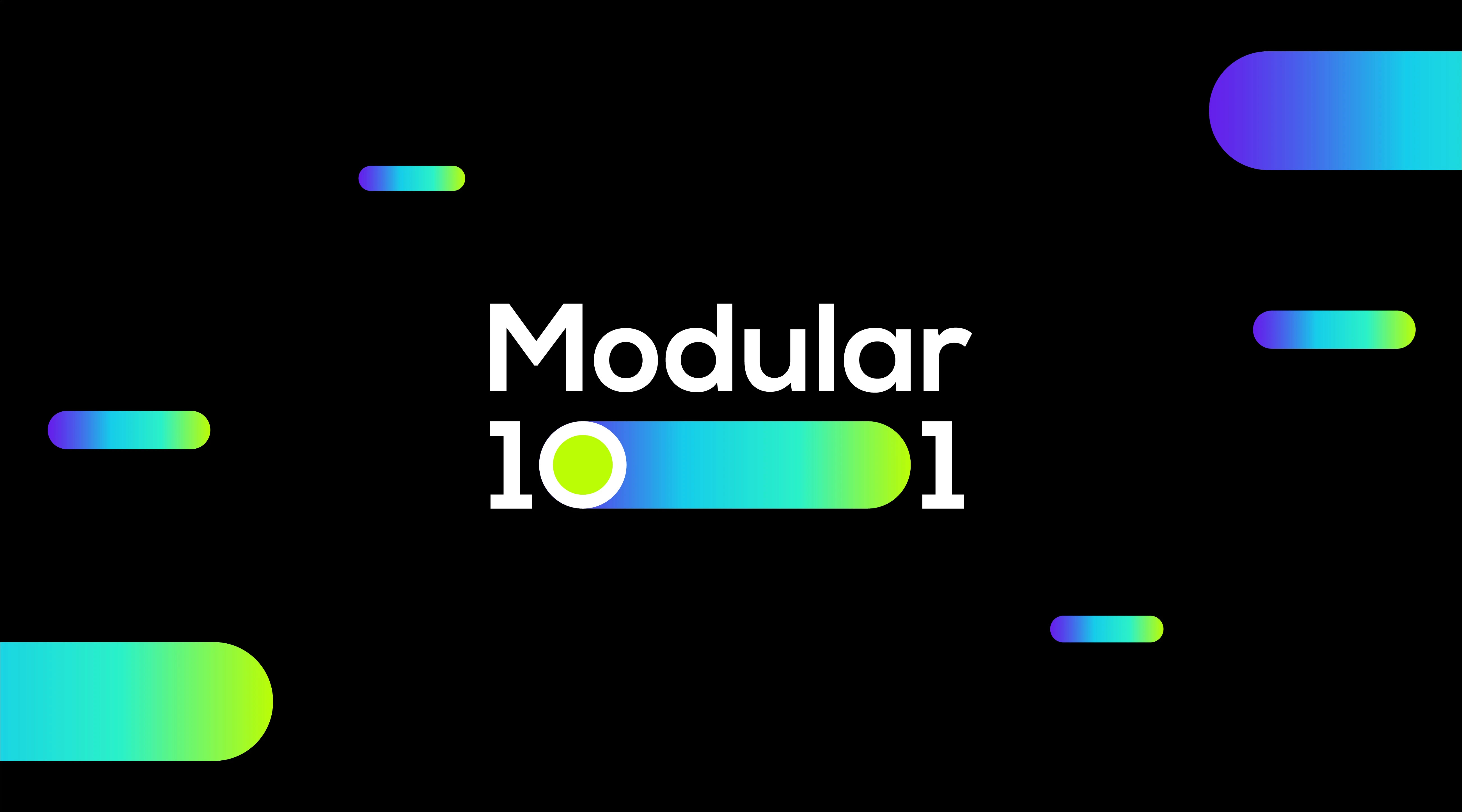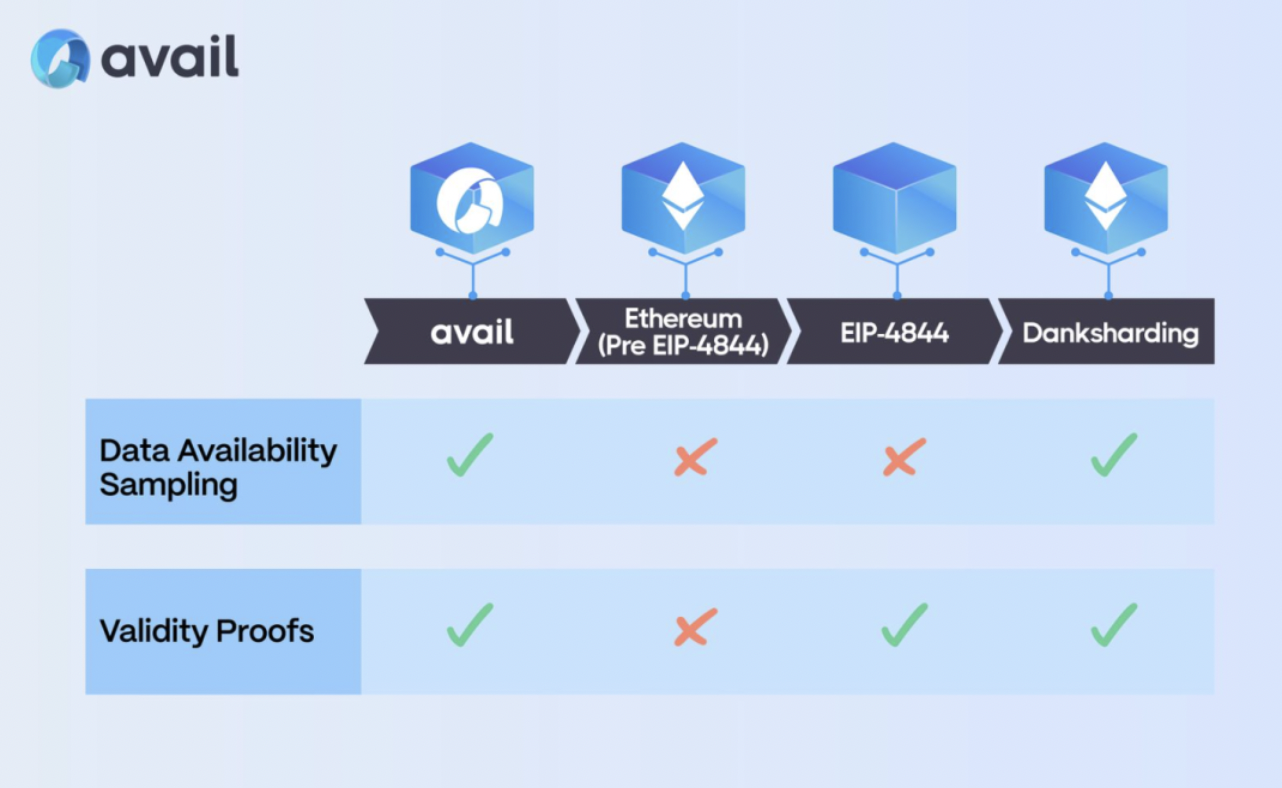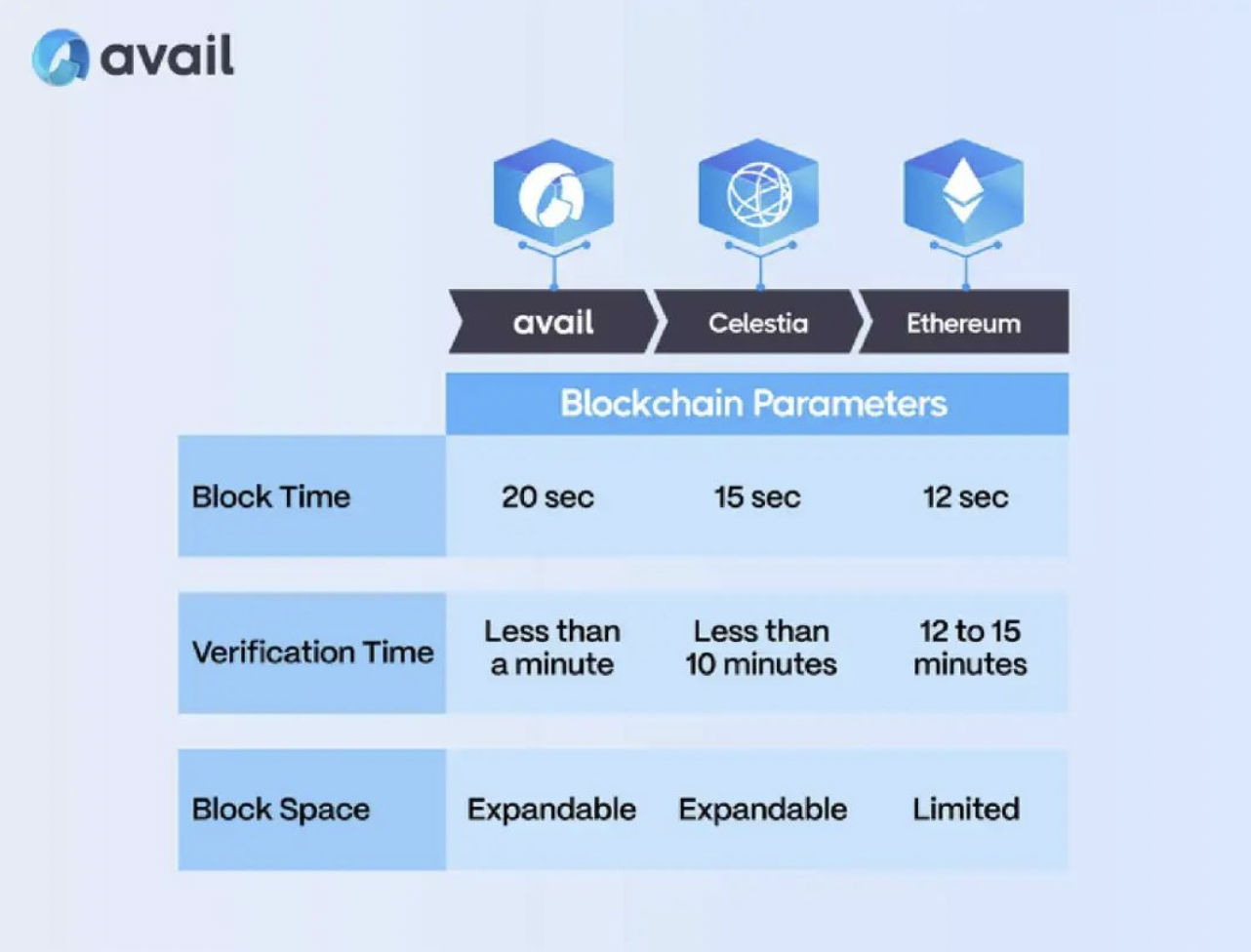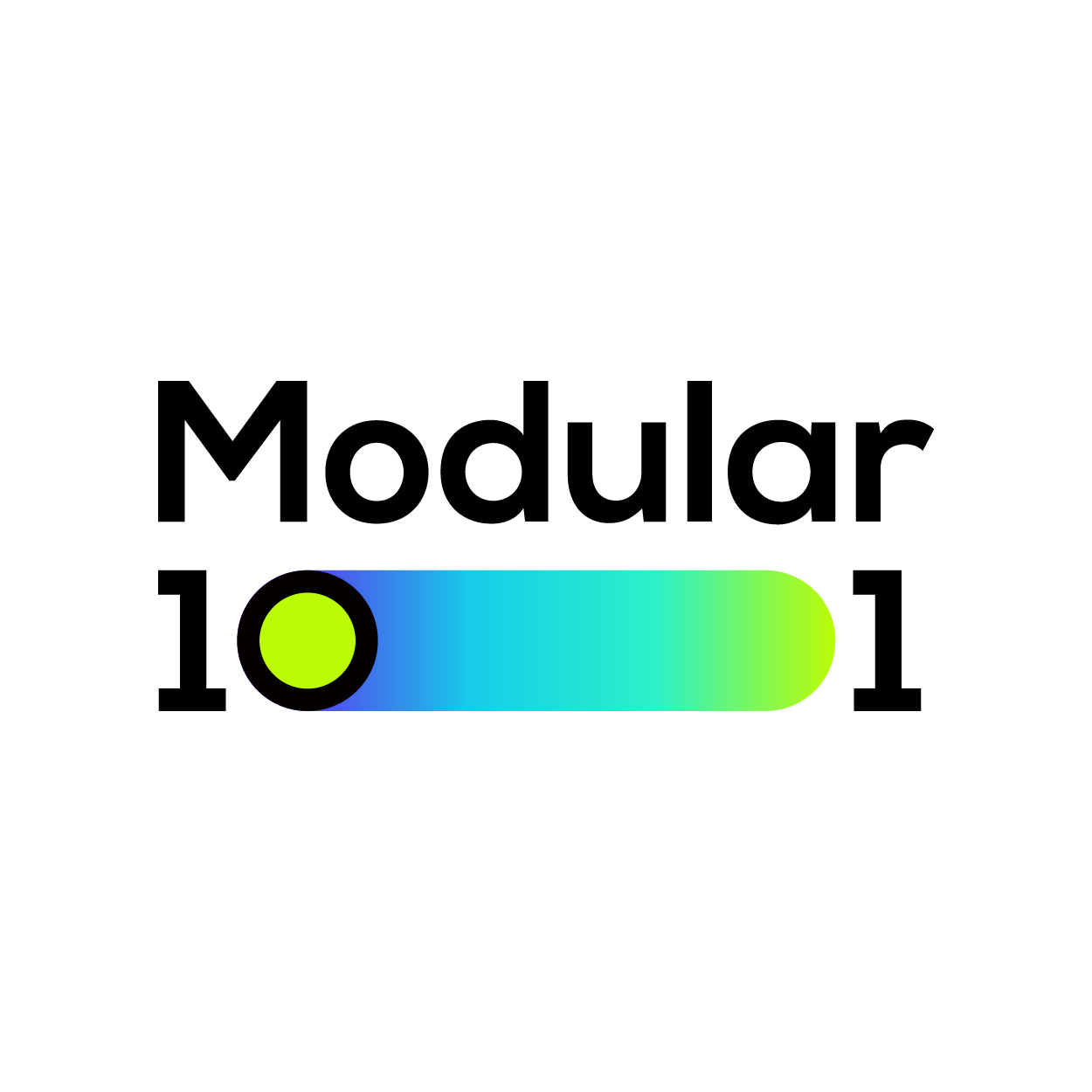Comprehensive comparison of the four major DA layers: Avail, Celestia, Ethereum, and EigenDA

What are the differences between different data availability tiers? In this article, we’ll explore the advantages and disadvantages of each approach.
In recent years, Layer 2 has begun to gain traction and adoption due to an increased focus on scaling execution. At the same time, more and more players are facing growth challenges due to limited block space and high costs. They began to realize that in order to effectively scale the blockchain, a scalable data availability layer was critical. This also means that they need a basic technology layer that can save costs and have larger block space to support various types of rollups.
Avail and several other teams are building scalable data availability solutions from scratch, while others, like Ethereum, are trying to increase the data availability capacity of existing blockchains. Regardless of the approach, one fact remains—the base layer developers choose today will determine their competitive advantage in the years to come.
Avail is part of a rapidly growing modular ecosystem that aims to increase data availability on the blockchain. In addition to Avail, there are other data availability (DA) solutions such as Celestia and EigenDA that are working towards the same goal. Various solutions are employing different strategies and technical paths to achieve blockchain scalability. As one example, Ethereum is currently adopting a technology called Proto-Danksharding, which is also known as EIP-4844. This technology is a step towards Ethereums long-term goal of full Danksharding technology.
This article will evaluate the advantages and disadvantages of each approach. We’ll highlight different design options to give you a comprehensive understanding. and help developers find the DA layer that works best for them.
Lets start with an overview and then drill down into each category:
cyber security
When considering the base layer, the security and resilience of the network are the first things of concern. Here are the key factors when checking network strength.
consensus mechanism
In consensus mechanisms, there is a fundamental dilemma between liveness and security. Liveness ensures transactions are processed quickly and the network keeps running, while security ensures transactions are accurate and secure. Different blockchain systems make different choices for their unique use cases to strike the right balance.
Avail uses two consensus mechanisms, BABE and GRANDPA, of the Polkadot SDK. BABE is mainly used to generate blocks. To ensure the liveliness of the network, it coordinates with validating nodes to determine which node will become the new block producer. GRANDPA is mainly responsible for the final confirmation of the block. When more than two-thirds of validators confirm that a chain contains a specific block, GRANDPA allows blocks that confirm all previous blocks up to this specific block. By combining these two mechanisms, Avail creates a hybrid ledger that increases the resiliency of its network, allowing it to survive temporary network partitions or massive node failures.
Avails design choices are similar to Casper and LMD GHOST used in Ethereum. LMD GHOST is Ethereums block production engine, which relies on probabilistic finality like BABE, while Casper FFG like GRANDPA is a finalization mechanism that provides finality guarantees.
Celestias design choice to use Tendermint allows them to determine blocks at generation time. However, the trade-off of such an option is the risk that the chain could be stopped if more than a third of the operators or validators go down. It is also important to note that block finality does not guarantee data availability. Celestia uses a fraud-proof design. In this design, even if a block has quickly achieved finality (that is, has been confirmed and cannot be changed), users still need to wait until they are confident that the relevant data is available.
Data Availability Committees (DAC) are a group of organizations or entities responsible for ensuring data accessibility or verifying data availability. When they confirm that the data is available, they use a specific cryptographic signature to express this confirmation. This means that when more than a majority of committee members agree that certain data is available, they will use a special digital signature to prove this fact.
EigenDA is a DAC that is not directly stored on the main chain of Ethereum, so it is called an off-chain DAC. Validators in the Ethereum network have the option to join EigenDA. When DAC members confirm the availability of certain data, they provide a smart contract-based proof or statement. This certification shows that they have verified the authenticity or integrity of the data. In addition, to ensure the order or structure of the data, DAC members also rely on an external, independent service to sort or organize the data.
Decentralization
When considering the security of a network, there are two key factors to consider: the total amount staked and the distribution of those stakes. The degree of decentralization, that is, how evenly distributed the pledged amount is, directly affects the security of a network. The cost of potential attacks is used to assess the security of the network. This is because if the staked amount is evenly distributed across a larger set of validators, a saboteur trying to attack the network would need to convince more nodes to claim the same staked amount.
Avail inherits Nominated Proof-of-Stake (NPoS) from Polkadot, which allows it to support up to 1,000 validators. Due to its sequential Phragmén method, a multi-winner election method, NPoS has an efficient reward distribution that can reduce the risk of staking centralization.
Avail is unique among all data availability solutions in its ability to sample data from its light-client P2P network, rather than relying entirely on full nodes to obtain data in the event of network issues or bottlenecks like other systems. . This feature sets Avail apart from other existing and upcoming data availability solutions. Because of this feature, Avail provides an efficient and reliable backup mechanism that ensures data availability even in the event of a failure. This further enhances the stability and anti-interference capabilities of Avails data availability network.
Celestia uses Tendermint as its consensus protocol, and the validator set can reach up to hundreds.
While Ethereum, as a single blockchain, serves as the gold standard for security with its over 900,000 validator nodes, the extent of the networks distribution is not fully reflected in this number.
In contrast, a DAC will typically include only a few nodes responsible for confirming the availability of blockchain data.
It is important to note that the re-staking process does not rely on the security gained from Ethereum, its security mainly depends on the total amount of Ether re-staking on the platform. This means that re-staking itself does not directly help improve the security of the platform, but only utilizes a portion of the existing pledges locked on Ethereum.
EigenDA aggregates signatures from its full nodes. However, its claims, verified via smart contracts, do not provide the same level of data availability (DA) guarantees compared to data availability sampling. EigenLayer adopts a re-staking strategy, which uses funds or assets that have been locked on Ethereum to pledge to support its own network. However, this approach has received some criticism because it may reuse certain validators and lead to overload of the consensus mechanism.
Additional consumption of execution environment
Over the past decade, single blockchains with smart contract capabilities have introduced groundbreaking innovations. However, even cutting-edge technologies of this era, such as Ethereum, where data availability, execution and settlement are merged into one, come with significant scalability limitations. These limitations have spurred the rise of Layer 2 technologies, which move execution off-chain, and the development of proposed improvements like EIP-4844 (also known as Proto-danksharding and Danksharding).
Divine smart contracts define the state and act as a bridge to rollups. In this approach, Ethereum serves as the authority and standard for verifying the accuracy of rollups.
Avail decouples execution and settlement from the base layer and allows rollups to publish data directly to Avail. The advantage of this modular approach is that those Avail-based rollups can leverage Avails P2P light client network to easily verify their status. Additionally, if the network is used to deliver proofs of execution, then rollups have the ability to upgrade themselves without having to rely on smart contracts or the base layer to define their state. This provides rollups with greater flexibility and autonomy. This new approach provides developers with a base layer that can be extended based on their needs, giving them the option of bridging settlement with any supported layer of their choice.
Celestia takes a similar approach to Avail. The only difference is that its light client cannot yet support the network in the event of a full node outage.
EigenDA also does not have a fixed settlement layer.
Development potential
In addition to the security and resilience of the data availability (DA) layer, the ability to accommodate the increased demands of the rollups and blockchains built on top of it is critical to their success. Let’s look at some key factors to consider.
Proof of effectiveness
When discussing validity proofs, it is critical to understand the trade-offs between fraud proofs and validity proofs in the data availability layer. The KZG commitment used by Avail is a proof of validity for ensuring DA, which reduces memory, bandwidth and storage requirements and provides simplicity, which means that the size of the proof is not affected by polynomial complexity. This makes KZG promised to be ideal for zero-knowledge-based blockchains, where efficiency, privacy, and scalability are all important.
Additionally, Avails light client can quickly access and sample data and ensure correct block encoding, providing data availability guarantees when new blocks are finalized, while fraud proofing requires waiting for the challenge period to expire. The combination of KZG commitments and Avails light client accelerates the verification process on Avail, allowing rollups or sovereign chains built on it to take advantage of its fast verification process and creates scalability for blockchain designs for years to come. and flexibility. This authentication method is a key differentiator between Avail and a DA layer like Celestia.
Celestia uses a secure hash function, which is much faster than KZG commitment generation. The trade-off here is that they must rely on fraud proofs to confirm the accuracy of erasure coding, which introduces potential delays in ensuring data availability guarantees.
Celestias light nodes cannot explicitly confirm whether data is available or if there are proofs of fraud that have not yet been received. In other words, the use of fraud proofs reduces the ability of the networks light nodes to unambiguously confirm the availability of data after sampling, since a necessary challenge period is required as part of optimistic verification.
EigenDA will use KZG commitments and only download small amounts of data, rather than complete data blocks, and employ validity proofs. Their approach is to use erasure coding to split data into smaller chunks and require operators to download and store only one chunk that is a fraction of the full data chunk size.
As for Ethereum, while the current version does not use validity proofs, EIP-4844 and full Danksharding will use validity proofs when implemented.
Extended capabilities
The proliferation of L2s is due to limitations on Ethereum, such as expensive costs and slow transactions. They have become Ethereums execution layer, driving increased demand for block space. Currently, the cost of publishing data to Ethereum is estimated to account for 70% to 90% of the total cost of rollups. This creates additional costs for validators and applications developed on Ethereum.
Base layers like Avail and Celestia are designed to solve this problem. They are optimized for data availability, with the ability to dynamically expand block sizes as demand increases. By combining light clients and Data Availability Sampling (DAS), they have the advantage of scaling data availability block sizes in response to increases in demand on their network. This means that as block space increases, applications built on top of it remain unaffected because light clients within these networks can execute DAS without downloading the entire block. This unique capability sets them apart from single blockchains.
As of September 2023, Ethereum has the largest community with a market capitalization of $191 billion. While protocols built on Ethereum enjoy economies of scale, they also face expensive transaction costs due to limited block space over the past few years. In the growth of rollups, the number of users and transaction volume have reached their peak, and rollups have become the best choice for execution. As blockchain technology becomes more prevalent, the demand for block space will only continue to increase.
Although DACs can scale due to their simple centralized approach, some rollups have used DACs as a temporary measure until they can design a decentralized DA solution.

Data availability sampling
Both Avail and Celestia support light clients with Data Availability Sampling (DAS), allowing light clients to provide minimum trust security. As mentioned earlier, the main difference is how validation is done and how Avails light-client P2P network replaces full nodes to support the network in the event of an outage or bottleneck.
In contrast, Ethereum after EIP-4844 will not be equipped with DAS. This means its light clients will not have this upgraded, least-trust security feature. Going one step further, Ethereums DA solution includes its smart contract environment. In full danksharding, DAS will be implemented to expand the blob space, which is expected to be implemented in the next few years.
EigenDAs security is built on trusting a small number of full nodes or other entities because it has no Data Availability Sampling (DAS). The integrity of the protocol relies on a supermajority of the committee being honest and at least one other entity having a copy of the data, similar to optimistic construction. Although the dual quorum approach improves security over a single quorum, it still falls short of the ideal of independent verification via DAS.
cost
Ethereum is the most expensive solution compared to congestion and demand. Even with EIP-4844, Ethereum will still be expensive because it only provides a one-time increase in block space. DACs are the cheapest, but this comes at the expense of taking a more central approach.
Without an execution layer, Avail and Celestia will be able to keep costs low. They can also easily increase block space, which Ethereum today cannot do without DAS.
As for EigenDA, it said it would introduce a flexible cost model with both variable and fixed fees, but its actual costs have not yet been announced.
Performance Highlights
Now that we have examined the growth potential, we will take a look at the performance of these blockchains.
block time

See the table above to see the times for each required build block.
Measuring the performance of a blockchain solely by the time it takes to construct a block is singular, as this metric only covers one aspect of the process from block confirmation to verification completion. Even with a consensus mechanism that provides instant finality, DA verification can take time when using fraud proof-based methods.
Ethereum uses Casper to finalize a block every 64-95 slots, which means Ethereum block finality is approximately 12-15 minutes.
EigenLayer is not a blockchain, but a set of smart contracts running on Ethereum. This means that it inherits the same deterministic time as Ethereum. So, if the user sends a transaction to rollup, rollup will need to forward the transaction data to EigenLayer to prove that the data is available. However, a transaction is only considered complete when an Ethereum block is finalized, which can cause delays even if the rollup has accepted the transaction. Methods to circumvent the problem by providing faster DA guarantees and cryptoeconomic measures are already being discussed.
block space
As rollups become the execution layer of the future, the demand for block space will only increase. DA layers like Avail and Celestia will be able to meet demand due to their modular design, while Ethereums block space growth will be limited. Avails Kate testnet has been configured with a block size of 2 MB, which is copied and erasure-coded to 4 MB. Avail is unique in its ability to increase block sizes using efficient client-side verification technology. Through internal benchmarks, Avail has tested block sizes up to 128 MB without difficulty.
Celestia is also able to increase block size as demand for block space increases, thanks to DAS.
EigenDA will scale throughput by decoupling DA and consensus, erasure coding, and direct unicast. However, this comes at the cost of rollups built on top not inheriting the censorship resistance of the base layer.
Summarize
Choosing a solid base layer to build on can be challenging. We hope this article helps readers learn more about the pros and cons of different design choices and choose the DA layer thats right for you.
To stay updated, follow us on Twitter and subscribe to our newsletter. If any of the points mentioned in this article require further clarification, please feel free to contact the team on the Avail forum.
Avail Twitter:https://twitter.com/AvailProject
Newsletter:http://eepurl.com/it4xbs?ref=blog.availproject.org
Avail Forum: https://forum.availproject.org/?ref=blog.availproject.org
Original link: https://blog.availproject.org/a-guide-to-selecting-the-right-data-availability-layer/#consensus-mechanisms
Compilation: Modular 101
read more:
Avails vision: Become the default DA layer for Ethereum rollup!
How modular blockchain creates richness and solves the scarcity problem of single chains



